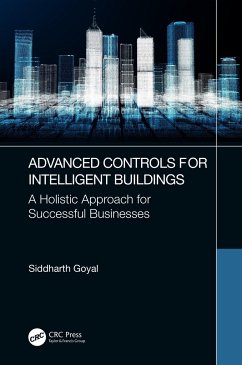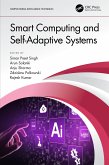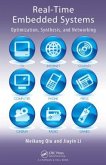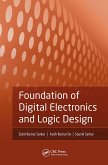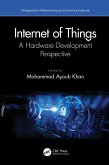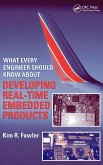Siddharth Goyal
Advanced Controls for Intelligent Buildings
A Holistic Approach for Successful Businesses
Siddharth Goyal
Advanced Controls for Intelligent Buildings
A Holistic Approach for Successful Businesses
- Gebundenes Buch
- Merkliste
- Auf die Merkliste
- Bewerten Bewerten
- Teilen
- Produkt teilen
- Produkterinnerung
- Produkterinnerung
The book focuses on technical and business aspects needed to select, design, develop and deploy control application successfully for multiple components in building systems. It provides guidance on developing an end-to-end system in relation to business fundamentals (distribution channels, marketing, supply-chain and financial management).
Andere Kunden interessierten sich auch für
![Smart Computing and Self-Adaptive Systems Smart Computing and Self-Adaptive Systems]() Smart Computing and Self-Adaptive Systems181,99 €
Smart Computing and Self-Adaptive Systems181,99 €![Real-Time Embedded Systems Real-Time Embedded Systems]() Meikang QiuReal-Time Embedded Systems194,99 €
Meikang QiuReal-Time Embedded Systems194,99 €![Open Systems Dependability Open Systems Dependability]() Open Systems Dependability156,99 €
Open Systems Dependability156,99 €![Foundation of Digital Electronics and Logic Design Foundation of Digital Electronics and Logic Design]() Subir Kumar SarkarFoundation of Digital Electronics and Logic Design130,99 €
Subir Kumar SarkarFoundation of Digital Electronics and Logic Design130,99 €![Embedded Systems and Robotics with Open Source Tools Embedded Systems and Robotics with Open Source Tools]() Nilanjan DeyEmbedded Systems and Robotics with Open Source Tools211,99 €
Nilanjan DeyEmbedded Systems and Robotics with Open Source Tools211,99 €![Internet of Things Internet of Things]() Internet of Things160,99 €
Internet of Things160,99 €![What Every Engineer Should Know About Developing Real-Time Embedded Products What Every Engineer Should Know About Developing Real-Time Embedded Products]() Kim R FowlerWhat Every Engineer Should Know About Developing Real-Time Embedded Products274,99 €
Kim R FowlerWhat Every Engineer Should Know About Developing Real-Time Embedded Products274,99 €-
-
-
The book focuses on technical and business aspects needed to select, design, develop and deploy control application successfully for multiple components in building systems. It provides guidance on developing an end-to-end system in relation to business fundamentals (distribution channels, marketing, supply-chain and financial management).
Hinweis: Dieser Artikel kann nur an eine deutsche Lieferadresse ausgeliefert werden.
Hinweis: Dieser Artikel kann nur an eine deutsche Lieferadresse ausgeliefert werden.
Produktdetails
- Produktdetails
- Verlag: Taylor & Francis Ltd (Sales)
- Seitenzahl: 244
- Erscheinungstermin: 5. Juli 2021
- Englisch
- Abmessung: 234mm x 156mm x 16mm
- Gewicht: 558g
- ISBN-13: 9781032009650
- ISBN-10: 1032009659
- Artikelnr.: 69947222
- Herstellerkennzeichnung
- Produktsicherheitsverantwortliche/r
- Europaallee 1
- 36244 Bad Hersfeld
- gpsr@libri.de
- Verlag: Taylor & Francis Ltd (Sales)
- Seitenzahl: 244
- Erscheinungstermin: 5. Juli 2021
- Englisch
- Abmessung: 234mm x 156mm x 16mm
- Gewicht: 558g
- ISBN-13: 9781032009650
- ISBN-10: 1032009659
- Artikelnr.: 69947222
- Herstellerkennzeichnung
- Produktsicherheitsverantwortliche/r
- Europaallee 1
- 36244 Bad Hersfeld
- gpsr@libri.de
Dr. Siddharth Goyal is currently working as the Director of Data Science Team at Divisions Maintenance Group (DMG). His professional experience ranges from research to product development, product management, strategy, technical leadership, and cross-functional team management. Previous experience includes key positions at LG Electronics, Johnson Controls, Pacific Northwest National Laboratory, University of Florida, National University of Singapore, Indian Institute of Science, Reliance Energy, and GE Motors. He has worked in multiple domains such as energy systems, intelligent buildings, software applications, artificial intelligence, aircraft and satellites, power plants, and robotics. In the past decade, his focus is tackling business challenges through technology in the smart buildings industry. Dr. Goyal holds a Ph.D. and an M.Sc. in Mechanical Engineering from the University of Florida, and a B.E. in Electrical Engineering from Punjab Engineering College. He has published numerous peer-reviewed papers in international conferences and journals. He has also submitted more than half a dozen patents on multiple new technologies and applications in the industry.
1 Building Systems
1.1 Introduction and Motivation
1.2 Building Types
1.2.1 Residential
1.2.2 Commercial
1.3 Building Systems
1.3.1 Overview: System Components and Functionality
1.3.2 HVAC Systems
1.3.2.1 AHU Systems
1.3.2.2 In-room Terminal Units
1.3.2.3 Heat Pumps
1.3.2.4 VRF (Variable Refrigerant Flow) Systems
1.4 Control System Architecture
1.5 Moving toward the Future: Smart/Intelligent Buildings
2 Sensing
2.1 Background and Overview
2.1.1 Characteristics
2.1.2 Analog vs. Digital
2.2 Virtual Sensors
2.2.1 Analytical
2.2.2 Empirical
2.3 Sensors Types and Availability in Buildings
2.3.1 Temperature Sensors
2.3.2 Pressure Sensors
2.3.3 Flow Rate Sensors
2.3.4 Speed Sensor
2.3.5 Electrical Sensors
2.3.6 Humidity Sensors
2.3.7 Light Sensors
2.3.8 Occupancy/Motion Sensors
2.3.9 Security Sensors
2.3.10 Air Quality Sensors
2.3.11 Outdoor Environmental Sensors
2.3.12 Position Sensors
2.3.13 Safety Sensors
2.3.14 Meters or Usage Sensors
2.3.15 Tracking Sensors
2.3.16 Other Sensors
3 Modeling
3.1 Modeling Approaches
3.1.1 White Box
3.1.2 Black Box
3.1.3 Grey Box
3.2 Modeling Process
3.2.1 Model Types
3.2.2 Order Reduction and Approximation
3.2.3 Calibration and Validation
3.3 Components and Systems
3.3.1 Fan
3.3.2 Chiller
3.3.3 Heat Exchanger
3.3.4 Pump
3.3.5 Damper
3.3.6 Thermal Models
3.3.7 Moisture and Humidity
3.3.8 Simulation Tools
3.4 Model Selection
4 Control
4.1 Control Product Types
4.2 Value of Control in Buildings
4.3 Control Approach
4.3.1 Centralized
4.3.2 Decentralized
4.3.3 Distributed
4.3.4 Hierarchical
4.3.4.1 Supervisory Control (SC)
4.4 Control Algorithms/Strategies
4.4.1 Bang-bang Control
4.4.2 Rule/Event-based Control
4.4.3 Finite State Machine (FSM)
4.4.4 PID (Proportional-integral-derivative) Control
4.4.5 Model Predictive Control (MPC)
4.4.6 Adaptive Control
4.4.6.1 Parameter Tuning
4.4.6.2 Reference Tuning
4.4.7 Economic control
4.4.8 Miscellaneous
4.5 Optimal Selection of Controls
5 Testing and Deployment
5.1 Test Bed Design
5.1.1 Simulation
5.1.2 Hardware-in-loop (HIL)
5.1.2.1 Controller-in-loop (CIL)
5.1.2.2 Equipment-in-loop (EIL)
5.1.3 Laboratory Testing
5.1.4 Field Demonstration
5.2 Product vs. Prototype vs. POC
5.3 Testing Methodology
5.3.1 Module-level
5.3.2 System-level
5.3.3 Feature-level
5.3.4 Other testing
5.4 Validation Mechanism
5.4.1 Eye-ball
5.4.2 Semi-automated
5.4.3 Fully-automated
5.5 Validation Criteria
5.6 Creating a Powerful Testing Infrastructure
5.7 Deployment
5.7.1 Packaging
5.7.2 Installation
5.7.3 Automatic Binding
5.7.4 Tracking
5.7.5 Update and Maintain
6 Control Use Cases, Artificial Intelligence, and Internet of
Things
6.1 Control Use Cases
6.1.1 Precooling and Preheating
6.1.2 Ice/Cold-water Storage System
6.1.3 Duct Static Pressure Reset
6.1.4 Optimal Start/Stop
6.1.5 Night Purge Ventilation
6.1.6 Demand Control Ventilation (DCV)
6.1.7 Temperature Setback
6.1.7.1 Domestic Hot Water Temperature Reset
6.1.7.2 Zone Temperature Reset
6.1.7.3 SA Temperature Reset
6.1.7.4 Refrigeration/Freeze Temperature Reset
6.1.8 Daylight Harvesting
6.1.9 Automatic Lights Shutoff
6.1.10 Light Dimming
6.1.11 Occupancy-based Control
6.1.12 Natural Heating and Cooling
6.1.13 High-traffic Elevator Control
6.1.14 Fault Detection and Diagnostics (FDD)
6.1.15 Building-to-Grid Integration
6.1.15.1 Peak Shaving and Load Shifting
6.1.15.2 Community-level Resource Coordination
6.1.15.3 Frequency Regulation Service
6.1.15.4 Demand Response Programs
6.1.16 Retrofit Measures
6.2 Artificial Intelligence (AI) and Machine Learning (ML)
6.2.1 Role of AI and ML in Building Controls
6.3 IoT and Controls
6.3.1 Why Is IoT Attractive Now?
6.3.2 IoT Components
6.3.2.1 Big Data Handling
6.3.2.2 Communication Network and Protocol
6.3.2.3 Device Management
6.3.2.4 Platform
6.3.2.5 Data Privacy and Security
6.3.2.6 Applications and Use Cases
6.3.3 IoT Value and Opportunities in Buildings
6.3.4 IoT Challenges in Buildings
7 Stakeholders and Channels
7.1 Stakeholders
7.1.1 Occupant
7.1.2 Tenant
7.1.3 Owner
7.1.4 Facility Manager
7.1.5 Building Engineer and Building Operator
7.1.6 Consultant
7.1.7 Contractor
7.1.8 Brokers/Representatives
7.1.9 Technician
7.1.10 Utility and Government
7.1.11 Other
7.2 Distribution Channel
7.2.1 Direct Channel
7.2.2 Indirect Channel
7.2.3 Hybrid Channel
7.3 Channel Power and Conflicts
8 Product Marketing Management
8.1 Product Research and Segmentation
8.1.1 Product Market Research
8.1.2 Customer Segmentation and Targeting
8.1.3 Market Adoption Behavior
8.2 Competitive Analysis and Product Positioning
8.2.1 Positioning and Competitive Advantage
8.2.2 Monitoring Competition
8.2.3 Growth Strategy
8.3 Product Strategy
8.3.1 Product Selection and Introduction
8.3.2 Project Management
8.3.3 Pricing Strategies
8.3.4 Advertising
8.3.5 Product Stages
8.3.6 Attract and Retain Customers
8.4 Industry Characteristics
8.4.1 Life Cycle Stage
8.4.2 Market Volatility
8.4.3 Regulation and Policy
8.4.4 Barrier-to-entry and Investment Requirement
8.4.5 Competition and Concentration Level
8.4.6 Globalization
8.4.7 Technology Progressiveness
8.4.8 Dependency Level
8.4.9 Industry Structure using Porter's Five Forces
8.5 Marketing Challenges and Opportunities in Building Controls
8.6 Growing Trends and Environmental Factors
9 Financial, Cost, and Supply Chain Management
9.1 Financial Concepts
9.1.1 Rate of Return and Interest Rate
9.1.2 Present Value vs. Future Value
9.1.3 Inflation
9.2 Project Selection-A Financial View
9.2.1 Return on Investment
9.2.2 Simple Payback Period
9.2.3 Net Present Value
9.3 Cost Management
9.3.1 Cost of Goods
9.3.1.1 Financial Factors
9.3.1.2 Non-financial Factors
9.3.2 Operational Expenses
9.3.2.1 Automation
9.3.2.2 Outsourcing
9.3.2.3 Workflow and Processes Optimization
9.3.2.4 Technology Adoption
9.4 Supply Chain Management
9.4.1 Supply Chain Management Example: Apple
9.4.2 Supply Chain Evolution: 1.0 to 5.0
9.4.3 Supply Chain Improvement Opportunities
9.4.4 Disruptions Preparation
9.4.5 Industrial Improvement and Impact
10 Controls Business Framework
10.1 Combined Technical and Business Perspective
10.1.1 Strategy and Marketing Management
10.1.2 Financial and Cost Management
10.1.3 Business Scenarios and Use Cases
10.1.4 Control Product/Services Development
10.1.5 Product Testing and Deployment
10.1.6 Building Systems and Iterative Improvement
10.1.7 Market Response and External Factors
10.2 Next-generation Building through Advanced Controls and
Applications
Alphabetical Index
1.1 Introduction and Motivation
1.2 Building Types
1.2.1 Residential
1.2.2 Commercial
1.3 Building Systems
1.3.1 Overview: System Components and Functionality
1.3.2 HVAC Systems
1.3.2.1 AHU Systems
1.3.2.2 In-room Terminal Units
1.3.2.3 Heat Pumps
1.3.2.4 VRF (Variable Refrigerant Flow) Systems
1.4 Control System Architecture
1.5 Moving toward the Future: Smart/Intelligent Buildings
2 Sensing
2.1 Background and Overview
2.1.1 Characteristics
2.1.2 Analog vs. Digital
2.2 Virtual Sensors
2.2.1 Analytical
2.2.2 Empirical
2.3 Sensors Types and Availability in Buildings
2.3.1 Temperature Sensors
2.3.2 Pressure Sensors
2.3.3 Flow Rate Sensors
2.3.4 Speed Sensor
2.3.5 Electrical Sensors
2.3.6 Humidity Sensors
2.3.7 Light Sensors
2.3.8 Occupancy/Motion Sensors
2.3.9 Security Sensors
2.3.10 Air Quality Sensors
2.3.11 Outdoor Environmental Sensors
2.3.12 Position Sensors
2.3.13 Safety Sensors
2.3.14 Meters or Usage Sensors
2.3.15 Tracking Sensors
2.3.16 Other Sensors
3 Modeling
3.1 Modeling Approaches
3.1.1 White Box
3.1.2 Black Box
3.1.3 Grey Box
3.2 Modeling Process
3.2.1 Model Types
3.2.2 Order Reduction and Approximation
3.2.3 Calibration and Validation
3.3 Components and Systems
3.3.1 Fan
3.3.2 Chiller
3.3.3 Heat Exchanger
3.3.4 Pump
3.3.5 Damper
3.3.6 Thermal Models
3.3.7 Moisture and Humidity
3.3.8 Simulation Tools
3.4 Model Selection
4 Control
4.1 Control Product Types
4.2 Value of Control in Buildings
4.3 Control Approach
4.3.1 Centralized
4.3.2 Decentralized
4.3.3 Distributed
4.3.4 Hierarchical
4.3.4.1 Supervisory Control (SC)
4.4 Control Algorithms/Strategies
4.4.1 Bang-bang Control
4.4.2 Rule/Event-based Control
4.4.3 Finite State Machine (FSM)
4.4.4 PID (Proportional-integral-derivative) Control
4.4.5 Model Predictive Control (MPC)
4.4.6 Adaptive Control
4.4.6.1 Parameter Tuning
4.4.6.2 Reference Tuning
4.4.7 Economic control
4.4.8 Miscellaneous
4.5 Optimal Selection of Controls
5 Testing and Deployment
5.1 Test Bed Design
5.1.1 Simulation
5.1.2 Hardware-in-loop (HIL)
5.1.2.1 Controller-in-loop (CIL)
5.1.2.2 Equipment-in-loop (EIL)
5.1.3 Laboratory Testing
5.1.4 Field Demonstration
5.2 Product vs. Prototype vs. POC
5.3 Testing Methodology
5.3.1 Module-level
5.3.2 System-level
5.3.3 Feature-level
5.3.4 Other testing
5.4 Validation Mechanism
5.4.1 Eye-ball
5.4.2 Semi-automated
5.4.3 Fully-automated
5.5 Validation Criteria
5.6 Creating a Powerful Testing Infrastructure
5.7 Deployment
5.7.1 Packaging
5.7.2 Installation
5.7.3 Automatic Binding
5.7.4 Tracking
5.7.5 Update and Maintain
6 Control Use Cases, Artificial Intelligence, and Internet of
Things
6.1 Control Use Cases
6.1.1 Precooling and Preheating
6.1.2 Ice/Cold-water Storage System
6.1.3 Duct Static Pressure Reset
6.1.4 Optimal Start/Stop
6.1.5 Night Purge Ventilation
6.1.6 Demand Control Ventilation (DCV)
6.1.7 Temperature Setback
6.1.7.1 Domestic Hot Water Temperature Reset
6.1.7.2 Zone Temperature Reset
6.1.7.3 SA Temperature Reset
6.1.7.4 Refrigeration/Freeze Temperature Reset
6.1.8 Daylight Harvesting
6.1.9 Automatic Lights Shutoff
6.1.10 Light Dimming
6.1.11 Occupancy-based Control
6.1.12 Natural Heating and Cooling
6.1.13 High-traffic Elevator Control
6.1.14 Fault Detection and Diagnostics (FDD)
6.1.15 Building-to-Grid Integration
6.1.15.1 Peak Shaving and Load Shifting
6.1.15.2 Community-level Resource Coordination
6.1.15.3 Frequency Regulation Service
6.1.15.4 Demand Response Programs
6.1.16 Retrofit Measures
6.2 Artificial Intelligence (AI) and Machine Learning (ML)
6.2.1 Role of AI and ML in Building Controls
6.3 IoT and Controls
6.3.1 Why Is IoT Attractive Now?
6.3.2 IoT Components
6.3.2.1 Big Data Handling
6.3.2.2 Communication Network and Protocol
6.3.2.3 Device Management
6.3.2.4 Platform
6.3.2.5 Data Privacy and Security
6.3.2.6 Applications and Use Cases
6.3.3 IoT Value and Opportunities in Buildings
6.3.4 IoT Challenges in Buildings
7 Stakeholders and Channels
7.1 Stakeholders
7.1.1 Occupant
7.1.2 Tenant
7.1.3 Owner
7.1.4 Facility Manager
7.1.5 Building Engineer and Building Operator
7.1.6 Consultant
7.1.7 Contractor
7.1.8 Brokers/Representatives
7.1.9 Technician
7.1.10 Utility and Government
7.1.11 Other
7.2 Distribution Channel
7.2.1 Direct Channel
7.2.2 Indirect Channel
7.2.3 Hybrid Channel
7.3 Channel Power and Conflicts
8 Product Marketing Management
8.1 Product Research and Segmentation
8.1.1 Product Market Research
8.1.2 Customer Segmentation and Targeting
8.1.3 Market Adoption Behavior
8.2 Competitive Analysis and Product Positioning
8.2.1 Positioning and Competitive Advantage
8.2.2 Monitoring Competition
8.2.3 Growth Strategy
8.3 Product Strategy
8.3.1 Product Selection and Introduction
8.3.2 Project Management
8.3.3 Pricing Strategies
8.3.4 Advertising
8.3.5 Product Stages
8.3.6 Attract and Retain Customers
8.4 Industry Characteristics
8.4.1 Life Cycle Stage
8.4.2 Market Volatility
8.4.3 Regulation and Policy
8.4.4 Barrier-to-entry and Investment Requirement
8.4.5 Competition and Concentration Level
8.4.6 Globalization
8.4.7 Technology Progressiveness
8.4.8 Dependency Level
8.4.9 Industry Structure using Porter's Five Forces
8.5 Marketing Challenges and Opportunities in Building Controls
8.6 Growing Trends and Environmental Factors
9 Financial, Cost, and Supply Chain Management
9.1 Financial Concepts
9.1.1 Rate of Return and Interest Rate
9.1.2 Present Value vs. Future Value
9.1.3 Inflation
9.2 Project Selection-A Financial View
9.2.1 Return on Investment
9.2.2 Simple Payback Period
9.2.3 Net Present Value
9.3 Cost Management
9.3.1 Cost of Goods
9.3.1.1 Financial Factors
9.3.1.2 Non-financial Factors
9.3.2 Operational Expenses
9.3.2.1 Automation
9.3.2.2 Outsourcing
9.3.2.3 Workflow and Processes Optimization
9.3.2.4 Technology Adoption
9.4 Supply Chain Management
9.4.1 Supply Chain Management Example: Apple
9.4.2 Supply Chain Evolution: 1.0 to 5.0
9.4.3 Supply Chain Improvement Opportunities
9.4.4 Disruptions Preparation
9.4.5 Industrial Improvement and Impact
10 Controls Business Framework
10.1 Combined Technical and Business Perspective
10.1.1 Strategy and Marketing Management
10.1.2 Financial and Cost Management
10.1.3 Business Scenarios and Use Cases
10.1.4 Control Product/Services Development
10.1.5 Product Testing and Deployment
10.1.6 Building Systems and Iterative Improvement
10.1.7 Market Response and External Factors
10.2 Next-generation Building through Advanced Controls and
Applications
Alphabetical Index
1 Building Systems
1.1 Introduction and Motivation
1.2 Building Types
1.2.1 Residential
1.2.2 Commercial
1.3 Building Systems
1.3.1 Overview: System Components and Functionality
1.3.2 HVAC Systems
1.3.2.1 AHU Systems
1.3.2.2 In-room Terminal Units
1.3.2.3 Heat Pumps
1.3.2.4 VRF (Variable Refrigerant Flow) Systems
1.4 Control System Architecture
1.5 Moving toward the Future: Smart/Intelligent Buildings
2 Sensing
2.1 Background and Overview
2.1.1 Characteristics
2.1.2 Analog vs. Digital
2.2 Virtual Sensors
2.2.1 Analytical
2.2.2 Empirical
2.3 Sensors Types and Availability in Buildings
2.3.1 Temperature Sensors
2.3.2 Pressure Sensors
2.3.3 Flow Rate Sensors
2.3.4 Speed Sensor
2.3.5 Electrical Sensors
2.3.6 Humidity Sensors
2.3.7 Light Sensors
2.3.8 Occupancy/Motion Sensors
2.3.9 Security Sensors
2.3.10 Air Quality Sensors
2.3.11 Outdoor Environmental Sensors
2.3.12 Position Sensors
2.3.13 Safety Sensors
2.3.14 Meters or Usage Sensors
2.3.15 Tracking Sensors
2.3.16 Other Sensors
3 Modeling
3.1 Modeling Approaches
3.1.1 White Box
3.1.2 Black Box
3.1.3 Grey Box
3.2 Modeling Process
3.2.1 Model Types
3.2.2 Order Reduction and Approximation
3.2.3 Calibration and Validation
3.3 Components and Systems
3.3.1 Fan
3.3.2 Chiller
3.3.3 Heat Exchanger
3.3.4 Pump
3.3.5 Damper
3.3.6 Thermal Models
3.3.7 Moisture and Humidity
3.3.8 Simulation Tools
3.4 Model Selection
4 Control
4.1 Control Product Types
4.2 Value of Control in Buildings
4.3 Control Approach
4.3.1 Centralized
4.3.2 Decentralized
4.3.3 Distributed
4.3.4 Hierarchical
4.3.4.1 Supervisory Control (SC)
4.4 Control Algorithms/Strategies
4.4.1 Bang-bang Control
4.4.2 Rule/Event-based Control
4.4.3 Finite State Machine (FSM)
4.4.4 PID (Proportional-integral-derivative) Control
4.4.5 Model Predictive Control (MPC)
4.4.6 Adaptive Control
4.4.6.1 Parameter Tuning
4.4.6.2 Reference Tuning
4.4.7 Economic control
4.4.8 Miscellaneous
4.5 Optimal Selection of Controls
5 Testing and Deployment
5.1 Test Bed Design
5.1.1 Simulation
5.1.2 Hardware-in-loop (HIL)
5.1.2.1 Controller-in-loop (CIL)
5.1.2.2 Equipment-in-loop (EIL)
5.1.3 Laboratory Testing
5.1.4 Field Demonstration
5.2 Product vs. Prototype vs. POC
5.3 Testing Methodology
5.3.1 Module-level
5.3.2 System-level
5.3.3 Feature-level
5.3.4 Other testing
5.4 Validation Mechanism
5.4.1 Eye-ball
5.4.2 Semi-automated
5.4.3 Fully-automated
5.5 Validation Criteria
5.6 Creating a Powerful Testing Infrastructure
5.7 Deployment
5.7.1 Packaging
5.7.2 Installation
5.7.3 Automatic Binding
5.7.4 Tracking
5.7.5 Update and Maintain
6 Control Use Cases, Artificial Intelligence, and Internet of
Things
6.1 Control Use Cases
6.1.1 Precooling and Preheating
6.1.2 Ice/Cold-water Storage System
6.1.3 Duct Static Pressure Reset
6.1.4 Optimal Start/Stop
6.1.5 Night Purge Ventilation
6.1.6 Demand Control Ventilation (DCV)
6.1.7 Temperature Setback
6.1.7.1 Domestic Hot Water Temperature Reset
6.1.7.2 Zone Temperature Reset
6.1.7.3 SA Temperature Reset
6.1.7.4 Refrigeration/Freeze Temperature Reset
6.1.8 Daylight Harvesting
6.1.9 Automatic Lights Shutoff
6.1.10 Light Dimming
6.1.11 Occupancy-based Control
6.1.12 Natural Heating and Cooling
6.1.13 High-traffic Elevator Control
6.1.14 Fault Detection and Diagnostics (FDD)
6.1.15 Building-to-Grid Integration
6.1.15.1 Peak Shaving and Load Shifting
6.1.15.2 Community-level Resource Coordination
6.1.15.3 Frequency Regulation Service
6.1.15.4 Demand Response Programs
6.1.16 Retrofit Measures
6.2 Artificial Intelligence (AI) and Machine Learning (ML)
6.2.1 Role of AI and ML in Building Controls
6.3 IoT and Controls
6.3.1 Why Is IoT Attractive Now?
6.3.2 IoT Components
6.3.2.1 Big Data Handling
6.3.2.2 Communication Network and Protocol
6.3.2.3 Device Management
6.3.2.4 Platform
6.3.2.5 Data Privacy and Security
6.3.2.6 Applications and Use Cases
6.3.3 IoT Value and Opportunities in Buildings
6.3.4 IoT Challenges in Buildings
7 Stakeholders and Channels
7.1 Stakeholders
7.1.1 Occupant
7.1.2 Tenant
7.1.3 Owner
7.1.4 Facility Manager
7.1.5 Building Engineer and Building Operator
7.1.6 Consultant
7.1.7 Contractor
7.1.8 Brokers/Representatives
7.1.9 Technician
7.1.10 Utility and Government
7.1.11 Other
7.2 Distribution Channel
7.2.1 Direct Channel
7.2.2 Indirect Channel
7.2.3 Hybrid Channel
7.3 Channel Power and Conflicts
8 Product Marketing Management
8.1 Product Research and Segmentation
8.1.1 Product Market Research
8.1.2 Customer Segmentation and Targeting
8.1.3 Market Adoption Behavior
8.2 Competitive Analysis and Product Positioning
8.2.1 Positioning and Competitive Advantage
8.2.2 Monitoring Competition
8.2.3 Growth Strategy
8.3 Product Strategy
8.3.1 Product Selection and Introduction
8.3.2 Project Management
8.3.3 Pricing Strategies
8.3.4 Advertising
8.3.5 Product Stages
8.3.6 Attract and Retain Customers
8.4 Industry Characteristics
8.4.1 Life Cycle Stage
8.4.2 Market Volatility
8.4.3 Regulation and Policy
8.4.4 Barrier-to-entry and Investment Requirement
8.4.5 Competition and Concentration Level
8.4.6 Globalization
8.4.7 Technology Progressiveness
8.4.8 Dependency Level
8.4.9 Industry Structure using Porter's Five Forces
8.5 Marketing Challenges and Opportunities in Building Controls
8.6 Growing Trends and Environmental Factors
9 Financial, Cost, and Supply Chain Management
9.1 Financial Concepts
9.1.1 Rate of Return and Interest Rate
9.1.2 Present Value vs. Future Value
9.1.3 Inflation
9.2 Project Selection-A Financial View
9.2.1 Return on Investment
9.2.2 Simple Payback Period
9.2.3 Net Present Value
9.3 Cost Management
9.3.1 Cost of Goods
9.3.1.1 Financial Factors
9.3.1.2 Non-financial Factors
9.3.2 Operational Expenses
9.3.2.1 Automation
9.3.2.2 Outsourcing
9.3.2.3 Workflow and Processes Optimization
9.3.2.4 Technology Adoption
9.4 Supply Chain Management
9.4.1 Supply Chain Management Example: Apple
9.4.2 Supply Chain Evolution: 1.0 to 5.0
9.4.3 Supply Chain Improvement Opportunities
9.4.4 Disruptions Preparation
9.4.5 Industrial Improvement and Impact
10 Controls Business Framework
10.1 Combined Technical and Business Perspective
10.1.1 Strategy and Marketing Management
10.1.2 Financial and Cost Management
10.1.3 Business Scenarios and Use Cases
10.1.4 Control Product/Services Development
10.1.5 Product Testing and Deployment
10.1.6 Building Systems and Iterative Improvement
10.1.7 Market Response and External Factors
10.2 Next-generation Building through Advanced Controls and
Applications
Alphabetical Index
1.1 Introduction and Motivation
1.2 Building Types
1.2.1 Residential
1.2.2 Commercial
1.3 Building Systems
1.3.1 Overview: System Components and Functionality
1.3.2 HVAC Systems
1.3.2.1 AHU Systems
1.3.2.2 In-room Terminal Units
1.3.2.3 Heat Pumps
1.3.2.4 VRF (Variable Refrigerant Flow) Systems
1.4 Control System Architecture
1.5 Moving toward the Future: Smart/Intelligent Buildings
2 Sensing
2.1 Background and Overview
2.1.1 Characteristics
2.1.2 Analog vs. Digital
2.2 Virtual Sensors
2.2.1 Analytical
2.2.2 Empirical
2.3 Sensors Types and Availability in Buildings
2.3.1 Temperature Sensors
2.3.2 Pressure Sensors
2.3.3 Flow Rate Sensors
2.3.4 Speed Sensor
2.3.5 Electrical Sensors
2.3.6 Humidity Sensors
2.3.7 Light Sensors
2.3.8 Occupancy/Motion Sensors
2.3.9 Security Sensors
2.3.10 Air Quality Sensors
2.3.11 Outdoor Environmental Sensors
2.3.12 Position Sensors
2.3.13 Safety Sensors
2.3.14 Meters or Usage Sensors
2.3.15 Tracking Sensors
2.3.16 Other Sensors
3 Modeling
3.1 Modeling Approaches
3.1.1 White Box
3.1.2 Black Box
3.1.3 Grey Box
3.2 Modeling Process
3.2.1 Model Types
3.2.2 Order Reduction and Approximation
3.2.3 Calibration and Validation
3.3 Components and Systems
3.3.1 Fan
3.3.2 Chiller
3.3.3 Heat Exchanger
3.3.4 Pump
3.3.5 Damper
3.3.6 Thermal Models
3.3.7 Moisture and Humidity
3.3.8 Simulation Tools
3.4 Model Selection
4 Control
4.1 Control Product Types
4.2 Value of Control in Buildings
4.3 Control Approach
4.3.1 Centralized
4.3.2 Decentralized
4.3.3 Distributed
4.3.4 Hierarchical
4.3.4.1 Supervisory Control (SC)
4.4 Control Algorithms/Strategies
4.4.1 Bang-bang Control
4.4.2 Rule/Event-based Control
4.4.3 Finite State Machine (FSM)
4.4.4 PID (Proportional-integral-derivative) Control
4.4.5 Model Predictive Control (MPC)
4.4.6 Adaptive Control
4.4.6.1 Parameter Tuning
4.4.6.2 Reference Tuning
4.4.7 Economic control
4.4.8 Miscellaneous
4.5 Optimal Selection of Controls
5 Testing and Deployment
5.1 Test Bed Design
5.1.1 Simulation
5.1.2 Hardware-in-loop (HIL)
5.1.2.1 Controller-in-loop (CIL)
5.1.2.2 Equipment-in-loop (EIL)
5.1.3 Laboratory Testing
5.1.4 Field Demonstration
5.2 Product vs. Prototype vs. POC
5.3 Testing Methodology
5.3.1 Module-level
5.3.2 System-level
5.3.3 Feature-level
5.3.4 Other testing
5.4 Validation Mechanism
5.4.1 Eye-ball
5.4.2 Semi-automated
5.4.3 Fully-automated
5.5 Validation Criteria
5.6 Creating a Powerful Testing Infrastructure
5.7 Deployment
5.7.1 Packaging
5.7.2 Installation
5.7.3 Automatic Binding
5.7.4 Tracking
5.7.5 Update and Maintain
6 Control Use Cases, Artificial Intelligence, and Internet of
Things
6.1 Control Use Cases
6.1.1 Precooling and Preheating
6.1.2 Ice/Cold-water Storage System
6.1.3 Duct Static Pressure Reset
6.1.4 Optimal Start/Stop
6.1.5 Night Purge Ventilation
6.1.6 Demand Control Ventilation (DCV)
6.1.7 Temperature Setback
6.1.7.1 Domestic Hot Water Temperature Reset
6.1.7.2 Zone Temperature Reset
6.1.7.3 SA Temperature Reset
6.1.7.4 Refrigeration/Freeze Temperature Reset
6.1.8 Daylight Harvesting
6.1.9 Automatic Lights Shutoff
6.1.10 Light Dimming
6.1.11 Occupancy-based Control
6.1.12 Natural Heating and Cooling
6.1.13 High-traffic Elevator Control
6.1.14 Fault Detection and Diagnostics (FDD)
6.1.15 Building-to-Grid Integration
6.1.15.1 Peak Shaving and Load Shifting
6.1.15.2 Community-level Resource Coordination
6.1.15.3 Frequency Regulation Service
6.1.15.4 Demand Response Programs
6.1.16 Retrofit Measures
6.2 Artificial Intelligence (AI) and Machine Learning (ML)
6.2.1 Role of AI and ML in Building Controls
6.3 IoT and Controls
6.3.1 Why Is IoT Attractive Now?
6.3.2 IoT Components
6.3.2.1 Big Data Handling
6.3.2.2 Communication Network and Protocol
6.3.2.3 Device Management
6.3.2.4 Platform
6.3.2.5 Data Privacy and Security
6.3.2.6 Applications and Use Cases
6.3.3 IoT Value and Opportunities in Buildings
6.3.4 IoT Challenges in Buildings
7 Stakeholders and Channels
7.1 Stakeholders
7.1.1 Occupant
7.1.2 Tenant
7.1.3 Owner
7.1.4 Facility Manager
7.1.5 Building Engineer and Building Operator
7.1.6 Consultant
7.1.7 Contractor
7.1.8 Brokers/Representatives
7.1.9 Technician
7.1.10 Utility and Government
7.1.11 Other
7.2 Distribution Channel
7.2.1 Direct Channel
7.2.2 Indirect Channel
7.2.3 Hybrid Channel
7.3 Channel Power and Conflicts
8 Product Marketing Management
8.1 Product Research and Segmentation
8.1.1 Product Market Research
8.1.2 Customer Segmentation and Targeting
8.1.3 Market Adoption Behavior
8.2 Competitive Analysis and Product Positioning
8.2.1 Positioning and Competitive Advantage
8.2.2 Monitoring Competition
8.2.3 Growth Strategy
8.3 Product Strategy
8.3.1 Product Selection and Introduction
8.3.2 Project Management
8.3.3 Pricing Strategies
8.3.4 Advertising
8.3.5 Product Stages
8.3.6 Attract and Retain Customers
8.4 Industry Characteristics
8.4.1 Life Cycle Stage
8.4.2 Market Volatility
8.4.3 Regulation and Policy
8.4.4 Barrier-to-entry and Investment Requirement
8.4.5 Competition and Concentration Level
8.4.6 Globalization
8.4.7 Technology Progressiveness
8.4.8 Dependency Level
8.4.9 Industry Structure using Porter's Five Forces
8.5 Marketing Challenges and Opportunities in Building Controls
8.6 Growing Trends and Environmental Factors
9 Financial, Cost, and Supply Chain Management
9.1 Financial Concepts
9.1.1 Rate of Return and Interest Rate
9.1.2 Present Value vs. Future Value
9.1.3 Inflation
9.2 Project Selection-A Financial View
9.2.1 Return on Investment
9.2.2 Simple Payback Period
9.2.3 Net Present Value
9.3 Cost Management
9.3.1 Cost of Goods
9.3.1.1 Financial Factors
9.3.1.2 Non-financial Factors
9.3.2 Operational Expenses
9.3.2.1 Automation
9.3.2.2 Outsourcing
9.3.2.3 Workflow and Processes Optimization
9.3.2.4 Technology Adoption
9.4 Supply Chain Management
9.4.1 Supply Chain Management Example: Apple
9.4.2 Supply Chain Evolution: 1.0 to 5.0
9.4.3 Supply Chain Improvement Opportunities
9.4.4 Disruptions Preparation
9.4.5 Industrial Improvement and Impact
10 Controls Business Framework
10.1 Combined Technical and Business Perspective
10.1.1 Strategy and Marketing Management
10.1.2 Financial and Cost Management
10.1.3 Business Scenarios and Use Cases
10.1.4 Control Product/Services Development
10.1.5 Product Testing and Deployment
10.1.6 Building Systems and Iterative Improvement
10.1.7 Market Response and External Factors
10.2 Next-generation Building through Advanced Controls and
Applications
Alphabetical Index

